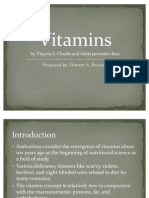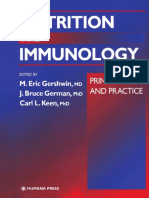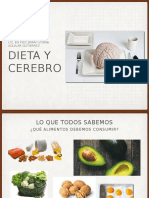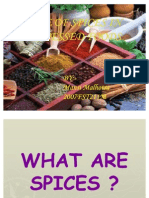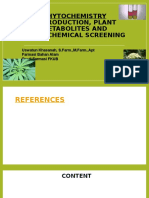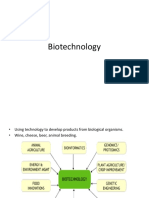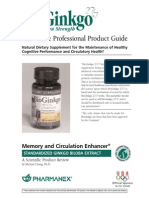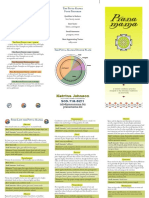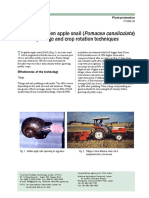What Are Phytochemicals
What Are Phytochemicals
Uploaded by
Lean Eng LeeCopyright:
Available Formats
What Are Phytochemicals
What Are Phytochemicals
Uploaded by
Lean Eng LeeOriginal Description:
Copyright
Available Formats
Share this document
Did you find this document useful?
Is this content inappropriate?
Copyright:
Available Formats
What Are Phytochemicals
What Are Phytochemicals
Uploaded by
Lean Eng LeeCopyright:
Available Formats
What are phytochemicals?
Phytochemicals are non-nutritive plant chemicals that have protective or
disease preventive properties. They are non-essential nutrients, meaning
that they are not required by the human body for sustaining life. It is wellknown that plant produce these chemicals to protect themselves but recent
research demonstrate that they can also protect humans against diseases.
There are more than thousand known phytochemicals. Some of the wellknown phytochemicals are lycopene in tomatoes, isoflavones in soy and
flavanoids in fruits.
How do phytochemicals work?
There are many phytochemicals and each works differently. These are some
possible actions:
Antioxidant - Most phytochemicals have antioxidant activity and
protect our cells against oxidative damage and reduce the risk of
developing certain types of cancer. Phytochemicals with antioxidant
activity: allyl sulfides (onions, leeks, garlic), carotenoids (fruits,
carrots), flavonoids (fruits, vegetables), polyphenols (tea, grapes).
Hormonal action - Isoflavones, found in soy, imitate human
estrogens and help to reduce menopausal symptoms and osteoporosis.
Stimulation of enzymes - Indoles, which are found in cabbages,
stimulate enzymes that make the estrogen less effective and could
reduce the risk for breast cancer. Other phytochemicals, which
interfere with enzymes, are protease inhibitors (soy and beans),
terpenes (citrus fruits and cherries).
Interference with DNA replication - Saponins found in beans
interfere with the replication of cell DNA, thereby preventing the
multiplication of cancer cells. Capsaicin, found in hot peppers, protects
DNA from carcinogens.
Anti-bacterial effect - The phytochemical allicin from garlic has antibacterial properties.
Physical action - Some phytochemicals bind physically to cell walls
thereby preventing the adhesion of pathogens to human cell walls.
Proanthocyanidins are responsible for the anti-adhesion properties
of cranberry. Consumption of cranberries will reduce the risk ofurinary
tract infections and will improve dental health.
How do we get enough phytochemicals?
Foods containing phytochemicals are already part of our daily diet. In fact,
most foods contain phytochemicals except for some refined foods such as
sugar or alcohol. Some foods, such as whole grains, vegetables, beans, fruits
and herbs, contain many phytochemicals. The easiest way to get more
phytochemicals is to eat more fruit (blueberries, cranberries, cherries,
apple,...) and vegetables (cauliflower, cabbage, carrots, broccoli,...). It is
recommended take daily at least 5 to 9 servings of fruits or vegetable. Fruits
and vegetables are also rich in minerals, vitamins and fibre and low in
saturated fat.
Future of phytochemicals
Phytochemicals are naturally present in many foods but it is expected that
through bioengineering new plants will be developed, which will contain
higher levels. This would make it easier to incorporate enough
phytochemicals with our food.
List of plants containing phytochemicals
Vegetables
Broccoli
Fennel
Garlic
Tomato
Wasabi
Fruits and Nuts
Acai
Almond
Bilberry
Black Raspberry
Blackberry
Blackcurrant
Blueberry
Cranberry
Grape
Guarana
Hazelnut
Mangosteen
Maqui Berry
Noni
Olive
Orange
Pomegranate
Red Raspberry
Sea Buckthorn
Wild Strawberry
Wolfberry
Medicinal Plants
Comfrey
Common Broom
Echinacea
Ginkgo
Goat's Rue
Lesser Celandine
Lungwort
Opium Poppy
Passion Fruit
Periwinkle
Red Bryony
Valerian
Wintergreen
Common Herbs
Aloe vera
American Ginseng
Clary Sage
Common Mallow
Common Yarrow
Cornsilk
Dandelion
Ground Ivy
Hawthorn
Hop
Hyssop
Indian Cress
Korean Ginseng
Lemon Balm
Lemon Verbena
Licorice
Marigold
Milk Thistle
Red clover
Rooibos
Rosemary
Sage
Schizandra
Stinging Nettle
Sweet Clover
Tea
Verbena
Wild Carrot
Wild Pansy
Woodruff
Beans and seeds
Cacao
Flaxseed
Soy
List of phytochemicals
Alkaloids
Monoterpenes
Caffeine
Geraniol
Theobromine
Limonene
Theophylline
Anthocyanins
Organosulfides
Allicin
Cyanidin
Glutathione
Malvidin
Indole-3-Carbinol
Isothiocyanates
Sulforaphane
Carotenoids
Beta-Carotene
Lutein
Lycopene
Other Phytochemicals
Damnacanthal
Coumestans
Digoxin
Flavan-3-Ols
Flavonoids
Phytic acid
Phenolic Acids
Epicatechin
Capsaicin
Ellagic Acid
Gallic acid
Rosmarinic acid
Tannic Acid
Hesperidin
Isorhamnetin
Kaempferol
Myricetin
Naringin
Nobiletin
Phytosterols
Beta-Sitosterol
Saponins
Proanthocyanidins
Quercetin
Rutin
Tangeretin
Stylbenes
Hydroxycinnamic Acids
Chicoric acid
Coumarin
Ferulic acid
Scopoletin
Pterostilbene
Resveratrol
Triterpenoids
Ursolic acid
Xanthophylls
Astaxanthin
Beta-Cryptoxanthin
Isoflavones
Daidzein
Genistein
Lignans
Silymarin
Monophenols
Hydroxytyrosol
Antioxidants
Antioxidants are phytochemicals, vitamins and other nutrients that protect
our cells from damage caused by free radicals. In vitro en in vivo studies
have shown that antioxidants help prevent the free radical damage that is
associated with cancer and heart disease. Antioxidants can be found in most
fruits and vegetables but also culinary herbs and medicinal herbs can contain
high levels of antioxidants. Dragland S and colleagues showed in their study
entitled "Several Culinary and Medicinal Herbs are Important Sources of
Dietary Antioxidants", and published in the Journal of Nutrition (2003 May)
that the antioxidant level of herbs can be as high as 465 mmol per 100 g.
A study in 2006 by Thompson HJ showed that a botanical diversity of fruits
and vegetables plays a role in the biological effect of antioxidant
phytochemicals. The consumption of smaller quantities of many
phytochemicals may result in more health benefits than the consumption of
larger quantities of fewer phytochemicals.
Herbs are usually considered as plant with aromatic properties and are
mainly used spice foods and for preparation of herbal teas. Herbs also
contain many phytochemicals including antioxidants. The aim of this study
was to determine the daily intake of antioxidants present in culinary and
medicinal herbs. To determine the level of antioxidants in herbs use was
made of the FRAP (Ferric Reducing Ability of Plasma) method. The results
show that there are large differences in antioxidant levels: the herb with the
highest level of antioxidants contains 1000 times more antioxidants than the
herb with the lowest level. The herbs with the highest levels of antioxidants
are oregano, sage, peppermint, lemon balm, clove, cinnamon, Cinnamomi
cortex and Scutellariae radix.
The levels of antioxidants found in culinary herbs were influenced by crop
year and season of harvesting. These are some levels of antioxidants in
common culinary herbs grown and harvested in Norway, (expressed as
mmol/100g):
Oregano
Sage
Peppermint
Thyme
Lemon Balm
Marjoram
Hyssop
Tansy, leaves
Purple Coneflower, flowers
Roseroot, stem
Chamomile
Angelica, leaves and stem
Roseroot, root and leaves
Angelica, root
Coriander
138
102
79
75
75
56
38
37
23
18
18
15
6
5
3
These are antioxidants levels found in dried commercial herbs (expressed as
mmol/100g):
Clove
Allspice
Cinnamon
Rosemary
Thyme
Marjoram
Bayberry leaves
Ginger
Nutmeg
Mustard
Cayenne
Garlic
Coriander
465
102
98
67
64
54
24
22
20
10
6
2
2
The researchers also tested some medicinal herbs, mainly Chinese and
Japanese herbs. These were the levels of antioxidants found (expressed as
mmol/100g):
Cinnamomi Cortex
Scutellariae Radix
Cimicifugae Rhizoma
Paeonaiae Radix
Glycyrrhizae Radix
Angelicae Radix
120
112
64
55
12
3
The researchers concluded that the intake of herbs contribute significant to
the overall daily intake of antioxidants. Intake of 1 g of culinary herbs may
contain 1 mmol antioxidants. Culinary herbs are even a better source of
antioxidants than other foods such as fruit, vegetables and cereals.
You might also like
- Indian Basic Grocery Translations - English To Kannada, Kadale Bele, Hurali Kalu-2Document7 pagesIndian Basic Grocery Translations - English To Kannada, Kadale Bele, Hurali Kalu-2GURU ADSNo ratings yet
- Victoria S Flower DictionaryDocument8 pagesVictoria S Flower Dictionaryxx.shyfier.xx8061100% (1)
- The Cannabible Collection IndexDocument17 pagesThe Cannabible Collection Indexkriskee13No ratings yet
- Phytochemicals in Foods: Elisha Gay C. Hidalgo, RNDDocument49 pagesPhytochemicals in Foods: Elisha Gay C. Hidalgo, RNDinkpen56789100% (1)
- Phytochemicals - Final PDFDocument2 pagesPhytochemicals - Final PDFS.K. AkhtarzaiNo ratings yet
- Case Pres Imperforated HymenDocument133 pagesCase Pres Imperforated Hymenpongiyalabs50% (2)
- Phytochemicals PDFDocument7 pagesPhytochemicals PDFAnca Irina SerebrianNo ratings yet
- VitaminsDocument13 pagesVitaminsRose Ann100% (1)
- Thesis Nutraceuticals Jef Pennings PDFDocument105 pagesThesis Nutraceuticals Jef Pennings PDFSaba IlyasNo ratings yet
- COLEUS FROSHKOLIIpdf PDFDocument6 pagesCOLEUS FROSHKOLIIpdf PDFrachelsantoso5259No ratings yet
- Nutrition and Immunology - Principles and Practice (PDFDrive)Document497 pagesNutrition and Immunology - Principles and Practice (PDFDrive)editfotiNo ratings yet
- Fat Soluble VitaminsDocument21 pagesFat Soluble VitaminsPragnesh BhalalaNo ratings yet
- Responsible NetizenshipDocument26 pagesResponsible NetizenshipMArk Anthony ArtisNo ratings yet
- Thymus Vulgaris L.: ThymeDocument23 pagesThymus Vulgaris L.: ThymerdineshNo ratings yet
- Dieta Y Cerebro: Lic. en Psic - Sarai Ivonne Aguilar GutierrezDocument19 pagesDieta Y Cerebro: Lic. en Psic - Sarai Ivonne Aguilar GutierrezSara GutiérrezNo ratings yet
- Essential and Non-Essential Fatty Acids PDFDocument4 pagesEssential and Non-Essential Fatty Acids PDFBj Delacruz100% (2)
- Essential Fatty Acids Makalah FinalDocument77 pagesEssential Fatty Acids Makalah FinalKeerthy VenthenNo ratings yet
- L2-Introduction To Human Nutrition and DieteticsDocument35 pagesL2-Introduction To Human Nutrition and DieteticskamarNo ratings yet
- Vitamins Are Organic Compounds Required in The Diet in Small Quantities To Perform Biological FunctionsDocument70 pagesVitamins Are Organic Compounds Required in The Diet in Small Quantities To Perform Biological FunctionsRose LiteNo ratings yet
- Seminar 12Document70 pagesSeminar 12Ishita MallickNo ratings yet
- Health Benefits of Functional FoodDocument46 pagesHealth Benefits of Functional FoodTina TalmadgeNo ratings yet
- Sti GonorrheaDocument6 pagesSti GonorrheaSulaiman NajirulNo ratings yet
- African HerbalsDocument15 pagesAfrican HerbalsArvind RanganathanNo ratings yet
- Plant Tissue Culture PDFDocument38 pagesPlant Tissue Culture PDFSheryl JoseNo ratings yet
- Human NutritionDocument42 pagesHuman Nutritionila03100% (2)
- Synthesis of FlavanoneDocument5 pagesSynthesis of FlavanonefikarisvitaNo ratings yet
- Microbes in Nutraceutical ProductsDocument24 pagesMicrobes in Nutraceutical ProductsDarkCupid MynheroNo ratings yet
- Milk Thistle Extract PreparationDocument13 pagesMilk Thistle Extract PreparationSinisa KusnjirNo ratings yet
- Nutrition Syllabus MSCDocument38 pagesNutrition Syllabus MSCdrrselvaraj100% (2)
- Transformation, Transduction, ConjugationDocument35 pagesTransformation, Transduction, ConjugationMaham ChNo ratings yet
- AndrogensDocument19 pagesAndrogensMirza Shaharyar BaigNo ratings yet
- Immunology Lecture 02 - 2018Document21 pagesImmunology Lecture 02 - 2018api-273068056No ratings yet
- Phytochemical Analysis of Plant ExtractsDocument23 pagesPhytochemical Analysis of Plant ExtractsjaninasuzetteNo ratings yet
- AMOEBIASISDocument18 pagesAMOEBIASISRosalie RosalesNo ratings yet
- By Ashutosh Gupta From BIT Mesra RanchiDocument31 pagesBy Ashutosh Gupta From BIT Mesra Ranchiexcel pro100% (1)
- Introduction To PharmacognosyDocument4 pagesIntroduction To PharmacognosySandra KonahapNo ratings yet
- Shereen-Lotfy Functional Beverages PDFDocument56 pagesShereen-Lotfy Functional Beverages PDFDr Arshad RazaNo ratings yet
- Chapter - 7 Novel Protein Foods: Alternative Sources of Protein For Human ConsumptionDocument14 pagesChapter - 7 Novel Protein Foods: Alternative Sources of Protein For Human Consumptionscience world100% (1)
- Herbal Remedies Using Centella Asiatica or AntananDocument2 pagesHerbal Remedies Using Centella Asiatica or Antananjhuli_2000100% (1)
- Terpenes and Terpenoids: Principles of Biochemistry BIOC-301 Dr. Gull-E-FaranDocument10 pagesTerpenes and Terpenoids: Principles of Biochemistry BIOC-301 Dr. Gull-E-FaranFahad NaeemNo ratings yet
- Biotechnology in Medical Industry: Prepared by Hilal Marangoz Sevgi DoğanDocument79 pagesBiotechnology in Medical Industry: Prepared by Hilal Marangoz Sevgi DoğanHilal MarangozNo ratings yet
- Biochemistry Chapter III PROTEINDocument137 pagesBiochemistry Chapter III PROTEINJonnel BarcelaNo ratings yet
- Role of Spices in Processed Foods Mansi SeminarDocument51 pagesRole of Spices in Processed Foods Mansi SeminarAjay SiwachNo ratings yet
- Complementary and Alternative Medicines Among ResiDocument10 pagesComplementary and Alternative Medicines Among ResiKaye Reyes-HapinNo ratings yet
- The Menstrual CycleDocument4 pagesThe Menstrual CycleMotilaldassNo ratings yet
- What Is MicrobiologyDocument13 pagesWhat Is MicrobiologyShifa RazaNo ratings yet
- Fat Soluble Vitamins: Functions and Its DeficiencyDocument31 pagesFat Soluble Vitamins: Functions and Its DeficiencyYasmin SyahiraNo ratings yet
- Phytochemistry (Introduction, Plant Metabolites and PhytochemicalDocument48 pagesPhytochemistry (Introduction, Plant Metabolites and Phytochemicalanisahanifatinr100% (1)
- PDF Nutrition CM 2 CU 6 LEC WEEK 7Document6 pagesPDF Nutrition CM 2 CU 6 LEC WEEK 7gabbyNo ratings yet
- CinnamonDocument2 pagesCinnamonchiquita.bodhicitta100% (3)
- Asthma and Nutrition ModuleDocument38 pagesAsthma and Nutrition ModuleDeepthi RamNo ratings yet
- BiotechnologyDocument15 pagesBiotechnologyUpanyaaNo ratings yet
- Food Microbiology CheeseDocument5 pagesFood Microbiology CheeseGeorge MarkasNo ratings yet
- Coleus Forskohlii and Its Forskolin A ReviewDocument5 pagesColeus Forskohlii and Its Forskolin A ReviewESSENCE - International Journal for Environmental Rehabilitation and ConservaionNo ratings yet
- 1.diet & Nutrition SyllabusDocument56 pages1.diet & Nutrition SyllabusJennifer SenNo ratings yet
- Tranexamic AcidDocument3 pagesTranexamic AcidMuhammad AliNo ratings yet
- Inhibiting The Growth of Pathogens in Vivo Using Antimicrobial AgentsDocument1 pageInhibiting The Growth of Pathogens in Vivo Using Antimicrobial AgentsLongyapon Sheena StephanieNo ratings yet
- Effect of PUFA On ReproductionDocument47 pagesEffect of PUFA On ReproductionMh BzNo ratings yet
- BioginkgoDocument8 pagesBioginkgoCherry San DiegoNo ratings yet
- SeedDocument22 pagesSeedSuporno Purakayastha100% (2)
- Essay 1 Fire DrillDocument2 pagesEssay 1 Fire DrillLean Eng LeeNo ratings yet
- Poem 1 There's Beem A Death in The Opposite HouseDocument16 pagesPoem 1 There's Beem A Death in The Opposite HouseLean Eng Lee100% (1)
- Common Error - Essay PT3 2015Document3 pagesCommon Error - Essay PT3 2015Lean Eng LeeNo ratings yet
- Objective and Text TransferDocument58 pagesObjective and Text TransferLean Eng LeeNo ratings yet
- Common Error - A Cleanliness CampaignDocument1 pageCommon Error - A Cleanliness CampaignLean Eng LeeNo ratings yet
- Pusat Tuisyen Tunas Aktif: Find The Mistakes in The Essay and Correct ThemDocument1 pagePusat Tuisyen Tunas Aktif: Find The Mistakes in The Essay and Correct ThemLean Eng LeeNo ratings yet
- Common Error VDocument3 pagesCommon Error VLean Eng LeeNo ratings yet
- Irregular Verb ListDocument4 pagesIrregular Verb ListLean Eng LeeNo ratings yet
- Article 29 He Taught Us To LoveDocument2 pagesArticle 29 He Taught Us To LoveLean Eng LeeNo ratings yet
- Focus Area First Year NotesDocument25 pagesFocus Area First Year NotesNEVIL DALENo ratings yet
- List of Exporting Companies in Canada For The Following ProductDocument14 pagesList of Exporting Companies in Canada For The Following ProductIda Ayu NayoanNo ratings yet
- Medicinal Plants 7th SemDocument10 pagesMedicinal Plants 7th SemO me khanNo ratings yet
- The Wildflowers of Israel LRDocument36 pagesThe Wildflowers of Israel LRMiriamNo ratings yet
- Pitta-Kapha Food Program: Katrina JohnsonDocument2 pagesPitta-Kapha Food Program: Katrina JohnsonPedja LeyNo ratings yet
- Soal Sas Gasal Kls 2 Bahasa InggrisDocument4 pagesSoal Sas Gasal Kls 2 Bahasa Inggrismbak yullNo ratings yet
- Main PDFDocument6 pagesMain PDFIndaaNo ratings yet
- Leaf & Flower ShapesDocument24 pagesLeaf & Flower ShapesNang BebNo ratings yet
- Produce Vegetable Crops-Direct SeedlingDocument19 pagesProduce Vegetable Crops-Direct Seedlinganon_905129417No ratings yet
- Harvest Calendar FullDocument6 pagesHarvest Calendar FullArjun SanchetiNo ratings yet
- Katalog EL 2020 EnglischDocument24 pagesKatalog EL 2020 EnglischGoran Marija StosicNo ratings yet
- Diversity of Herbaceous Species in The Rajshahi Metropolitan Area of BangladeshDocument14 pagesDiversity of Herbaceous Species in The Rajshahi Metropolitan Area of BangladeshIJAR JOURNALNo ratings yet
- Blumea BalsamiferaDocument6 pagesBlumea Balsamiferaalejandro jeanNo ratings yet
- The Edible Asian Garden - Rosalind Creasy PDFDocument113 pagesThe Edible Asian Garden - Rosalind Creasy PDFIsabellaVoyerNo ratings yet
- The English Garden 201005Document132 pagesThe English Garden 201005Vojislav Ribar100% (1)
- Weed AlbumDocument40 pagesWeed Albumreignover100% (3)
- Control of Golden Apple Snail (Pomacea Canaliculata) by Tillage and Crop Rotation TechniquesDocument2 pagesControl of Golden Apple Snail (Pomacea Canaliculata) by Tillage and Crop Rotation Techniquesrattus argentiventerNo ratings yet
- Fruitrop f160 p25 EngDocument1 pageFruitrop f160 p25 EngjihedwardNo ratings yet
- Fertilizer Recommendation GuideDocument28 pagesFertilizer Recommendation GuideSaqeebNo ratings yet
- Medical - Plants - of - Myanmar - PDF Filename - UTF-8''Medical Plants of MyanmarDocument122 pagesMedical - Plants - of - Myanmar - PDF Filename - UTF-8''Medical Plants of MyanmarMee MeeNo ratings yet
- ALULA LandscapeDocument164 pagesALULA LandscapeAbdullazizMansourNo ratings yet
- Directory MKTGDocument262 pagesDirectory MKTGPanduranga reddyNo ratings yet
- Aloe VeraDocument14 pagesAloe VeraBhavika PawadeNo ratings yet
- Chef Speciality List 102813Document1 pageChef Speciality List 102813Anonymous I3jTWn5No ratings yet
- Identifying Weeds - Gca672-2017Document28 pagesIdentifying Weeds - Gca672-2017Brian Onang'oNo ratings yet
- Herbal Mini-CourseDocument92 pagesHerbal Mini-CourselauraritonNo ratings yet
- Progress Report EslrDocument20 pagesProgress Report Eslrapi-644152622No ratings yet







